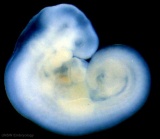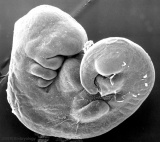BGDB Sexual Differentiation - Early Embryo: Difference between revisions
No edit summary |
|||
| Line 7: | Line 7: | ||
| | | | ||
<wikiflv width="560" height="588" autoplay="true" position="left">Stage13_GITlarge.flv|File:Stage13-GIT-icon.jpg</wikiflv> | <wikiflv width="560" height="588" autoplay="true" position="left">Stage13_GITlarge.flv|File:Stage13-GIT-icon.jpg</wikiflv> | ||
[[Movie_-_Gastrointestinal_Tract_3D_stage_13|Week 4-5 embryo (stage 13)]] | [[Movie_-_Gastrointestinal_Tract_3D_stage_13|Week 4-5 embryo (stage 13)]] | ||
Revision as of 15:24, 29 May 2011
| Practical 12: Sex Determination | Early Embryo | Late Embryo | Fetal | Postnatal | Abnormalities | 2011 Audio |
Week 4 to 5
|
<wikiflv width="560" height="588" autoplay="true" position="left">Stage13_GITlarge.flv|File:Stage13-GIT-icon.jpg</wikiflv> |
Begin by observing the internal structure of the embryo at the end of week 4 and the beginning of week 5
Colour code:
|
Kidney and Mesonephric Duct
|
<Flowplayer width="356" height="500" autoplay="true">Urogenital_sinus_001.flv</Flowplayer> |
Now go back and observe the development of the intermediate mesoderm.
Next observe the changes occuring in the hindgut region (yellow) ending in the embryo at the cloaca.
Primitive Urogenital SinusThis looped animation shows the next stage in septation of the urogenital sinus between Week 4 and 6. The initial cloaca is divided by the urorectal septum. The posterior portion forms the rectum and the anterior portion forms the primitive urogenital sinus. The superior part of the primitive urogenital sinus forms the urinary bladder, this and the rectum are the same for both sexes. The inferior part of the primitive urogenital sinus forms different structures in males and females. The constricting part forms the prostatic urethra (male) or the membranous urethra (female), beneath this region the expanded space is the definitive urogenital sinus forms the penile urethra (male) or vagina vestibule (female). Note the animation is simplified, as the cloacal membrane appears to break down before the septum can fuse with it. Several different defects in both sexes can occur if this septation process is not correctly aligned (rectourethral fistula, rectovaginal fistula). Gonad DevelopmentMale TestisThis looped animation shows the development of the male gonad showing medullary sex cords. The paramesonephric duct (red, left) degenerates under the influence of Mullerian duct inhibitory factor (MDIF) secreted by sertoli cells (differentiated by SRY expression). The mesonephric duct (purple) differentiates under the influence of Testosterone secreted by Leydig cells. Within the testes these mesonephric tubules grow towards the medullary sex cords and will form the rete teste. The mesonephric duct extending out of the gonad forms the ductus deferens. The medullary sex cords (orange) form testis cords that later differentiate into solid seminiferous tubules which become hollow and actively produce spermatazoa during puberty. The tunica albuginea (white) covers the testis and bands extend inward to form connective tissue septa. Female OvaryThis looped animation shows the development of the female gonad showing cortical sex cords. The mesonephric duct (purple) degenerates, small remnants may remain as epoophoron and paroophoron (in the mesentry of the ovary) and Gartner's cycts (near vagina). The paramesonephric duct (red, left) grows forming the oviduct (uterine horn) and the end opens into the peritoneal cavity and terminates in fimbria (finger-like extensions). Away from the ovary, the two paramesonephric ducts fuse in the midline to form the uterus. The cortical sex cords (orange) form after the primary sex cords degenerate and mesothelium forms secondary cords. The surrounding connective tissue (pink) differentiates to form follicle cells. Gonadal Development ComparisonNow directly compare the development of the male and female gonad (these may not be synchronised).
References
BGDB: Lecture - Gastrointestinal System | Practical - Gastrointestinal System | Lecture - Face and Ear | Practical - Face and Ear | Lecture - Endocrine | Lecture - Sexual Differentiation | Practical - Sexual Differentiation | Tutorial
Glossary Links
Cite this page: Hill, M.A. (2024, May 5) Embryology BGDB Sexual Differentiation - Early Embryo. Retrieved from https://embryology.med.unsw.edu.au/embryology/index.php/BGDB_Sexual_Differentiation_-_Early_Embryo
|

